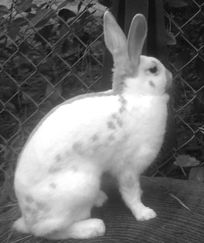The breeds we raise are:
Thriantas

The Thrianta was introduced into the United States of America in 1996 by Judith Oldenburg-Graf, Glen Carr, Bob Whitman, and Tommy and Diane Thompson and was recognized as a breed by ARBA in 2005.
Recognized Colors:
Standard (Red).
Shown as:
Standard.
The Thrianta is considered a 4 class breed (Senior Buck, Senior Doe, Junior Buck, Junior Doe).
A Thrianta will not be show quality if it has a white belly or underside of its tail; slate ear lacing or slate undercolor; or any ARBA general all-breed disqualifications as listed in the ARBA Standard of Perfection.
In order to be able to be shown at an ARBA sanctioned show, a Thrianta which is over 6 months of age must weigh more than 4 pounds, but not more than 6 pounds. Most judges want them to be around 5 1/2 pounds. If the Thrianta is under 6 months old they must weigh more than 2 1/2 pounds, yet not over 5 pounds.
Recognized Colors:
Standard (Red).
Shown as:
Standard.
The Thrianta is considered a 4 class breed (Senior Buck, Senior Doe, Junior Buck, Junior Doe).
A Thrianta will not be show quality if it has a white belly or underside of its tail; slate ear lacing or slate undercolor; or any ARBA general all-breed disqualifications as listed in the ARBA Standard of Perfection.
In order to be able to be shown at an ARBA sanctioned show, a Thrianta which is over 6 months of age must weigh more than 4 pounds, but not more than 6 pounds. Most judges want them to be around 5 1/2 pounds. If the Thrianta is under 6 months old they must weigh more than 2 1/2 pounds, yet not over 5 pounds.
English Spots

The English Spot is a full arch breed which are judged while being allowed to move and run up and down the show table.
Recognized Colors:
Black, Blue, Chocolate, Grey, Gold, Lilac, Gold, Tortoise (Tort).
Shown as:
Black, Blue, Chocolate, Grey, Gold, Lilac, Tortoise (Tort).
The English Spot is considered a 4 class breed (Senior Buck, Senior Doe, Junior Buck, Junior Doe).
An English Spot will not be show quality if it is missing a cheek spot or has a double cheek spot, has more than one stray head spot, has a herringbone (spine marking) with a break larger (or several breaks equaling) than 1/4 inch, or any ARBA general all-breed disqualifications as listed in the ARBA Standard of Perfection.
In order to be able to be shown at an ARBA sanctioned show, an English Spot which is over 6 months of age must weigh more than __ pounds (bucks) or __ pounds (does), but not more than __ pounds (bucks) or __ pounds (does). Most judges want them to be around 6 - 7 pounds. If the English Spot is under 6 months old they must weigh more than 3 pounds, yet not over 6 pounds.
Recognized Colors:
Black, Blue, Chocolate, Grey, Gold, Lilac, Gold, Tortoise (Tort).
Shown as:
Black, Blue, Chocolate, Grey, Gold, Lilac, Tortoise (Tort).
The English Spot is considered a 4 class breed (Senior Buck, Senior Doe, Junior Buck, Junior Doe).
An English Spot will not be show quality if it is missing a cheek spot or has a double cheek spot, has more than one stray head spot, has a herringbone (spine marking) with a break larger (or several breaks equaling) than 1/4 inch, or any ARBA general all-breed disqualifications as listed in the ARBA Standard of Perfection.
In order to be able to be shown at an ARBA sanctioned show, an English Spot which is over 6 months of age must weigh more than __ pounds (bucks) or __ pounds (does), but not more than __ pounds (bucks) or __ pounds (does). Most judges want them to be around 6 - 7 pounds. If the English Spot is under 6 months old they must weigh more than 3 pounds, yet not over 6 pounds.
All information was taken from my knowledge as a rabbit breeder and many years spent studying ARBA's Guidebook and ARBA's Standard of Perfection.
